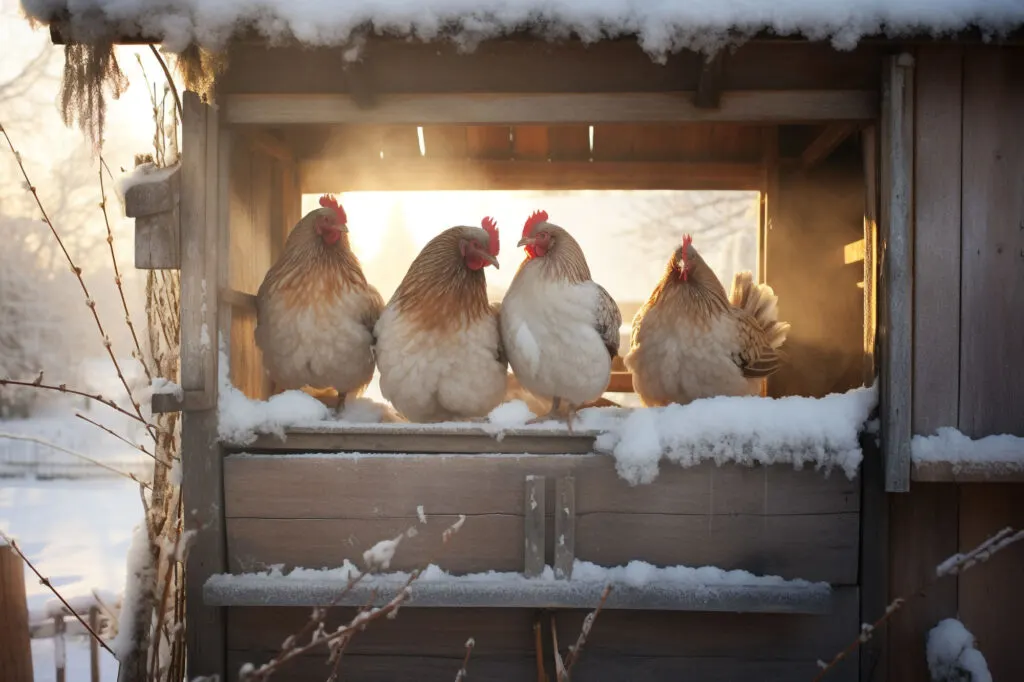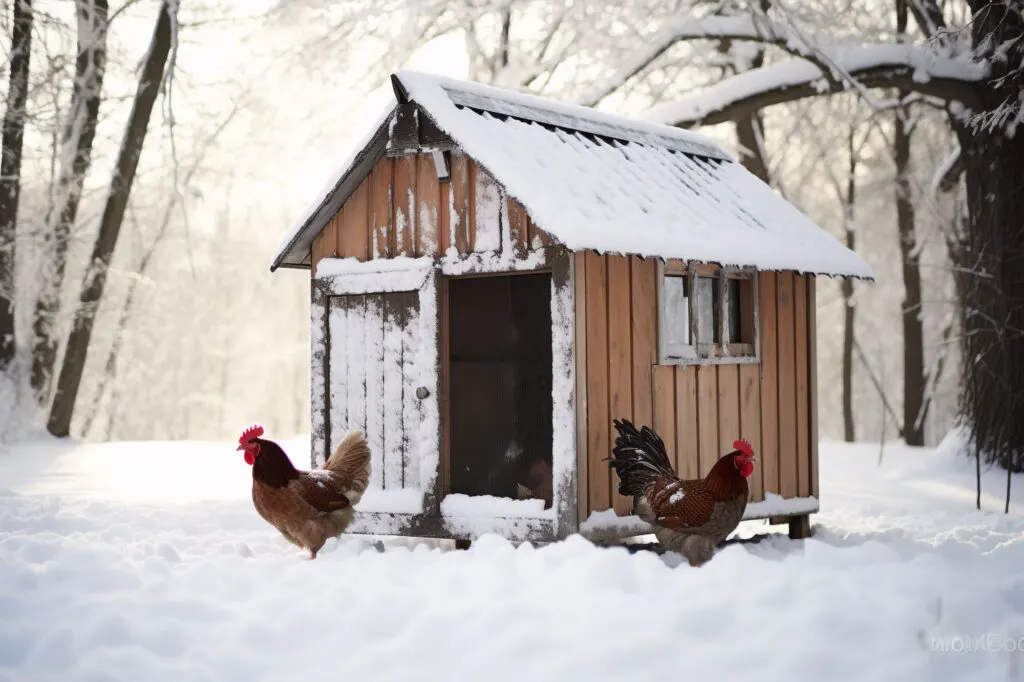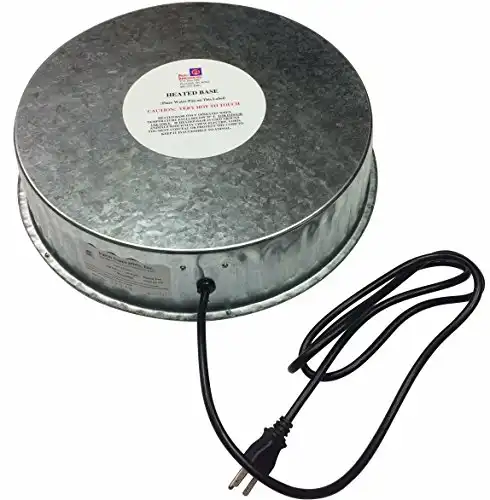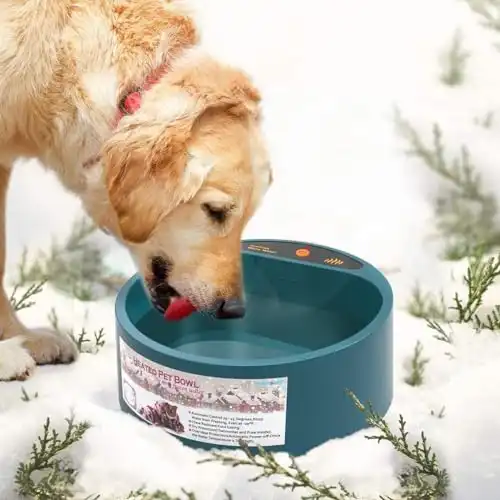Winter brings picture-perfect snowfalls, the silence of nature, and… frozen chicken water. Every backyard chicken enthusiast knows that maintaining a water source in the coop during winter is one of the trickier parts of poultry care.
But fear not; we’re here to ensure your flock has fresh, drinkable water through the coldest months without causing a spike in your electric bill, and you won’t have to resort to manual ice-breaking marathons.
In this guide, we’ll delve into several ways to keep your chickens’ water from freezing.
The importance of fresh water access
First things first: water is non-negotiable when it comes to animals. It’s not just about quenching thirst; water aids in digestion, regulates body temperature, and is critical for egg production.
Even in the cold, chickens require consistent access to water. Without water, they won’t eat as much, which will negatively affect their health and egg-laying. Plus, dehydration can set in quickly, even amidst freezing temperatures.
Traditional methods of giving chickens access to water might involve continuously replacing frozen water with fresh or hot water, which demands constant vigilance.
Some folks might try a DIY approach, placing a light bulb near the water source to provide heat. This method is fraught with risks — think electrical shorts or, worse, fire hazards, especially with flammable materials commonplace in a chicken coop.

(This post contains affiliate links, which means we make a small commission if you purchase through the links, at no extra cost to you.)
Strategies to keep chicken water from freezing
Now, let’s hatch some plans for keeping that water ice-free!
Metal vs. plastic waterers
When choosing between metal and plastic waterers, each material offers distinct advantages, and understanding these can help you make an informed decision based on your coop’s specific needs.
Metal waterers, often made of stainless steel or galvanized steel, are renowned for their durability and longevity. They’re resistant to the pecking damage chickens love to inflict on… well, everything.
Metal waterers become even more effective during winter when used with a heated base. The metal conducts heat efficiently, warming the water enough to prevent freezing. It’s an energy-efficient method since you’re directly heating the container rather than the surrounding environment.
However, there’s a caveat: a metal chicken waterer without a heated element can be counterproductive in freezing temperatures. They can lose heat rapidly in cold weather, and there’s also the risk of your chicken’s wattles freezing onto the cold metal surface, much like a tongue on a frozen pole.
- Made of heavy duty galvanized steel
- Vacuum process produces a constant flow of water
- 2 gallon double drinker provides for up to 51 poultry or game chicks. 5 gallon double drinker provides for up to 80 poultry or game chicks
On the flip side, plastic waterers might not have the same heat-conductive properties, but they offer other benefits. They are generally lighter, making them easier to clean and refill, and are less prone to freezing temperatures than their metal counterparts.
Plastic is less likely to cause injury should the birds peck at it or if their wattles touch the surface during extreme cold.
Using a heated base is still recommended with plastic waterers to prevent freezing. There are even all-in-one solutions available where the heating element is designed specifically for plastic, ensuring safety and adequate heat distribution.
For the eco-conscious chicken owner, it’s worth noting that newer models of plastic waterers are being made from recyclable materials or UV-resistant plastics that combat the degrading effects of sunlight, extending their usability.

Innovative insulation techniques
Insulation is a powerful ally in your battle against frozen water. It reduces the heat exchange between the water and the surrounding cold air, providing a passive, energy-efficient solution to keep your chickens’ water in a liquid state. Let’s explore some creative yet practical ways to insulate your chickens’ water.
Repurposing old tires: An old tire has surprising insulative properties. The rubber creates a barrier between the cold ground and the water container, preventing the quick transfer of heat. You can place a water bucket or a black rubber tub within a tire and then pack straw, hay, or wood shavings around it.
These materials will trap heat, adding an extra layer of insulation. This setup doesn’t just slow down the freezing process; it also raises the waterer off the ground, reducing the likelihood of it getting soiled with bedding or droppings.
Utilizing cinder blocks: Cinder blocks can be much more than coop décor; they have a functional purpose in the cold. They absorb and store heat when the temperature is warmer and then gradually release it as the temperature drops.
Placing a water container on a cinder block creates a slow-releasing heat source underneath it. For added insulation, you can even nestle the waterers into the hollows of the blocks. Filling the gaps around the waterer with straw or sand can provide extra insulation, forming a barrier against the cold air.
Incorporating natural insulators: Sometimes, the simplest solutions are right around us. Nature offers materials like straw, hay, or wood shavings that are excellent at trapping air and heat.
Wrapping your water containers with these materials or packing them around and under the containers can create a thick layer of insulation. However, ensure these materials stay dry for optimal performance, as wetness significantly diminishes their insulative properties.
DIY Insulated Boxes: Creating a DIY insulated box for the hands-on chicken owner can be rewarding and a practical solution to freezing temps. You can construct a box that houses the water container using materials like polystyrene or styrofoam.
These materials are excellent insulators and are relatively easy to work with. Cut out a portion that allows your chickens to drink comfortably, and you’ve got a custom, insulated space that significantly slows the freezing process. Consider lining the interior with reflective insulation to bounce heat back onto the water source for enhanced performance.
Harnessing heat sources
A dedicated device, like a submersible aquarium heater, tank heater, or even a simple heat lamp, can efficiently maintain water temperature. These are particularly handy when the mercury dips into the single digits. Keep in mind, most of these will require running an extension cord to your chicken coop, if you don’t have power to the coop.
Electric water heaters and heated bases: We briefly touched on these above, but electric water heaters, including heated bases, are among the most reliable solutions for keeping your flock’s water from freezing. They’re designed to provide just enough heat to keep water in a liquid state without wasting energy on overheating.
These heaters come in various designs, some compatible with both metal and plastic waterers, and are an excellent investment for those frigid months. Look for those with thermostatic controls that regulate the temperature based on the surroundings, thus conserving energy.
Heat lamps: While heat lamps can be an effective way to provide warmth in your coop and keep your chickens’ water above freezing, they must be used with extreme caution due to the risk of fire. If you’re considering a heat lamp, opt for models with infrared bulbs that produce more heat than light.
Regardless of the type, it’s critical to ensure the lamp is securely fastened, away from any flammable materials, and out of reach of your chickens. It’s also wise to inspect your heat lamps regularly for any signs of wear on the cord, the security of the fixtures, and any potential hazards.
Installing a smoke detector in your coop is another layer of precaution that could be a lifesaver. Since your coop may not be near your house, look for models that can alert your phone to any fire danger.
Heated pet bowls: Heated pet bowls are a hassle-free option, perfect for smaller flocks. These bowls come with a built-in heating element and a thermostat to prevent the water from freezing. They’re generally low-power, which helps keep the electric bill in check, and are a good option for those who prefer an all-in-one solution.
The heated water bowl will keep water from freezing in winter. A great choice for providing water for outdoor feral animals and small livestock.
Top-quality BPA-free plastic material, electronics are sealed safely inside the bowl, with stainless anti-bite wire.
DIY light bulb and cinder block heater: For smaller coops or milder climates, a simple light bulb can sometimes provide enough heat to keep water from freezing. Enclosing a low-wattage bulb in a cinder block and placing the waterer on top creates a heated base.
This method is inexpensive and can be quite effective. However, it’s essential to ensure that the setup is stable and that the bulb is far enough from any surfaces to prevent overheating or fire hazards.
Heat tape: Heat tape, usually used to prevent pipes from freezing in homes, can be wrapped around metal waterers or along the base of a water setup. It’s an energy-efficient way to apply heat directly where it’s needed. When using heat tape, follow all manufacturer instructions to prevent overheating or melting, especially with plastic components.
Utilizing the sun
It’s not all about cranking up the heat. Energy conservation is key in running a cost-effective coop, especially in winter.
Using black rubber buckets or tubs is a natural, energy-free tactic to help keep your flock’s water from freezing. These containers absorb sunlight and retain heat, slowing the freezing process significantly. It’s a simple concept and won’t cost you a penny in electricity! In very cold temperatures, these tubs will still freeze, but will will do so slower than plastic or metal water containers.

Also, consider the placement of your coop to utilize passive heating. Maximizing sunlight exposure by positioning the chicken run in sunnier spots can increase the temperature of the chickens’ water.
Ping pong ball trick
For a simple hack, try floating a few ping pong balls on the surface of the water. These keep it moving as chickens drink and peck at the balls, making it more difficult for ice to form.
This method is surprisingly effective and can be an excellent backup to use in conjunction with other methods.
Preparing for cold spells
Preparing for winter can feel like a lot of work, but a bit of prevention is worth pounds of cure. This goes for everything on a homestead, especially preparing livestock for winter.
- Stocking up: Keep extra water containers on hand in case you need them. Wider ones are better; water freezes from the top, so containers with a larger surface area can slow the process.
- Regular checks: You’ll have to be diligent about keeping an eye on your chickens’ water containers. If they do freeze, and you don’t have any of the heating options mentioned above, regularly break the ice that forms on top of the water to give your chickens continuous access to drinking water below.
- Have a backup method: If your power goes out or your heating system malfunctions, plan an alternative way to keep your flock hydrated. On the coldest days, you may simply have to replace frozen water bowls with fresh water periodically.
There’s no one-size-fits-all solution for caring for your flock in the winter months. Whether you find success with a heated pet bowl, heat tape, or even something as simple as a plastic bottle filled with hot water, the key is consistent monitoring and being proactive in your approach.
Remember, your goal is straightforward: provide a consistent supply of unfrozen water to your chickens in the most efficient, cost-effective way possible. So, wrap up, stay warm, and keep those waterers flowing.




